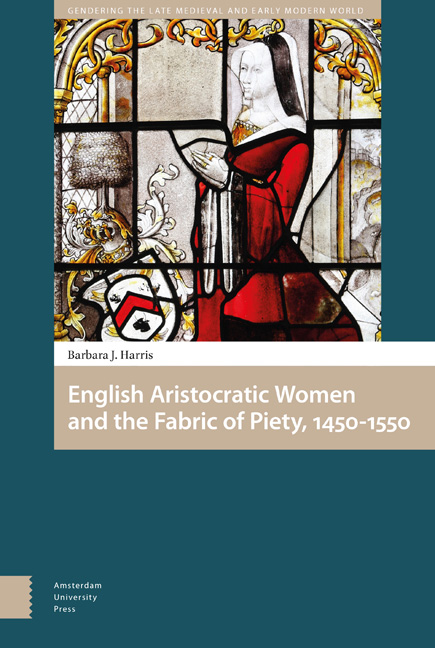Book contents
- Frontmatter
- Dedication
- Contents
- Abbreviations
- Illustrations
- Acknowledgements
- Preface
- Introduction
- 1 Tombs: Honoring the Dead
- 2 Chantries: The Quest for Perpetual Prayers
- 3 Building for the Congregation: Roofs, Aisles, and Stained Glass
- 4 Adorning the Liturgy: Luxury Fabrics and Chapel Plate
- 5 Almshouses and Schools: Prayers and Service to the Community
- 6 Defining Themselves
- 7 Epilogue: Destruction and Survival
- Conclusion
- Appendix 1 Patrons of the Fabric of the Church
- Appendix 2 Patrons of Tombs
- Appendix 3 Location of Tombs in Churches
- Appendix 4 Choice of Burial Companion
- Appendix 5 Women Who Commissioned Chantries
- Appendix 6 Commissions of Stained-Glass Windows
- Appendix 7 Additions or Major Repairs to Churches
- Appendix 8 Bequests of Vestments
- Appendix 9 Patrons of Almshouses or Schools
- Glossary
- Select Bibliography
- Archival Sources
- Index
6 - Defining Themselves
Published online by Cambridge University Press: 11 December 2020
- Frontmatter
- Dedication
- Contents
- Abbreviations
- Illustrations
- Acknowledgements
- Preface
- Introduction
- 1 Tombs: Honoring the Dead
- 2 Chantries: The Quest for Perpetual Prayers
- 3 Building for the Congregation: Roofs, Aisles, and Stained Glass
- 4 Adorning the Liturgy: Luxury Fabrics and Chapel Plate
- 5 Almshouses and Schools: Prayers and Service to the Community
- 6 Defining Themselves
- 7 Epilogue: Destruction and Survival
- Conclusion
- Appendix 1 Patrons of the Fabric of the Church
- Appendix 2 Patrons of Tombs
- Appendix 3 Location of Tombs in Churches
- Appendix 4 Choice of Burial Companion
- Appendix 5 Women Who Commissioned Chantries
- Appendix 6 Commissions of Stained-Glass Windows
- Appendix 7 Additions or Major Repairs to Churches
- Appendix 8 Bequests of Vestments
- Appendix 9 Patrons of Almshouses or Schools
- Glossary
- Select Bibliography
- Archival Sources
- Index
Summary
In 1558, Mary Neville, Lady Dacre, commissioned Hans Eworth, a leading Flemish painter resident in England, to paint her portrait. The occasion was almost certainly to record the success of her long campaign to secure restoration of the Dacre titles for her surviving son Gregory. The titles had forfeited to the Crown in 1541 when her husband, Thomas, Lord Dacre, was executed for murder.
Seated in an armchair at her desk, Lady Dacre dominates the picture spatially and expressively. The contrast with the small portrait of her husband in the background could not be more striking and underscores her triumph in rescuing their children from the consequences of his crime. Dacre's rich black gown and dark fur mantle signify her status as a respectable, wealthy widow, the embroidered sleeves and collar of her chemise providing the only contrast to the dark colors. She is wearing minimal jewelry: rings and a simple chain necklace barely visible at the opening of her collar. To indicate her piety, she is holding an open prayer book in her left hand.
Challenging the image of Lady Dacre as a conventional devout widow, however, is the object she is holding in her other hand—a quill pen. The pen was in fact the weapon she had used to conduct her seventeen-year-long struggle for restoration of the Dacre titles. Eworth's portrait, the first of an English aristocratic woman writing or about to write, thus memorialized her success in deploying a skill long considered inappropriate for women.
Furthermore, in commissioning the portrait, Lady Dacre was as careful about what was omitted from the painting as about what it included. Most notably, it omits any reference to the fact that she had married twice after her first husband's execution and was the mother of six children by her third spouse. These facts would have undermined the image she was fashioning of herself as a devout noble widow dedicated to her first husband's memory and the future of their children.
The following year, Lady Dacre ordered another painting from Eworth, this time a joint portrait of herself and Gregory, the Dacre heir. Once again, she dominates the picture, presenting herself as serious and formidable, while Gregory appears to be something of a fop.
- Type
- Chapter
- Information
- English Aristocratic Women's Religious Patronage 1450-1550 , pp. 115 - 134Publisher: Amsterdam University PressPrint publication year: 2018

